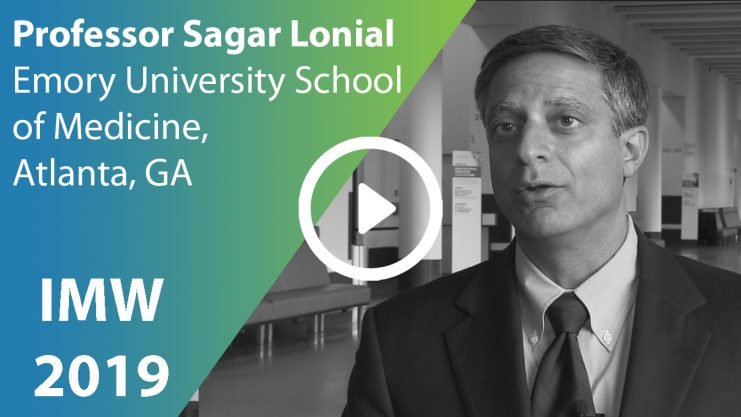Advertisment
Relapsed/refractory myeloma: ongoing challenges and emerging hope

Pomalidomide with bortezomib and dexamethasone is one of the best options for multiple myeloma patients who have relapsed while on lenalidomide, but other data are in the offing that could provide even more options, said Professor Philippe Moreau, head of the haematology department at University Hospital in Nantes, France.
Written by Thomas R.Collins.
With more patients being treated with lenalidomide in the front-line setting until their disease progresses, clinicians will more frequently be faced with situations in which it makes little sense to rely on lenalidomide in a second-line regimen, Professor Moreau said in a session at the International Myeloma Workshop.
Results recently released from the OPTIMISMM trial suggest that, for now, a pomalidomide-bortezomib-dexamethasone (PVd) is an attractive option for these patients. Among the patients who were refractory to front-line lenalidomide, progression-free survival (PFS) was 18 months for patients on this triplet, compared to 9 months for bortezomib-dexamethasone.
Data from ENDEAVOR, for bortezomib and carfilzomib alone, and CASTOR, for daratumumab combinations, do not include results for patients who are lenalidomide-refractory after one line of therapy, he said.
“PVd is definitely a good combination and potentially better than ENDEAVOR or CASTOR with dara-Vd, in my opinion,” Professor Moreau said.
Three Phase 3 trials that are ongoing will provide even more data for patients in the relapsed or refractory setting and who have already been treated with lenalidomide: CANDOR, on carfilzomib, dexamethasone, and daratumumab; IKEMA on carfilzomib, dexamethasone, and the anti-CD38 isatuximab; and APOLLO, on pomalidomide, dexamethasone, and daratumumab.
“We are eagerly awaiting the results,” Professor Moreau said.
For patients who have progressed after multiple lines of therapy, the options are far more limited, said Professor Sagar Lonial, MD, chair of haematology and oncology at Emory University, but new options are being explored.
The XPO1-inhibitor selinexor yielded an objective response rate of 26% for patients who’d had a median of 7 prior lines of therapy, with a progression-free survival of about 3 months. Adverse events have been a problem for the drug, with two-thirds of patients on single-agent therapy suffering nausea and half suffering anorexia. But when combined at a lower dose with bortezomib, pomalidomide, carfilzomib or other agents, the response rate jumps and the adverse events have seemed to abate, Professor Lonial said.
“That’s the other key part of the benefit of combination therapy, is the use of a lower dose of selinexor,” he said. “That may allow you to give a longer duration of therapy.”
Venetoclax, the BCL2-inhibitor that has been successful in lymphoma, has not been as resounding a triumph in myeloma, because most myeloma cell lines are not dependent on BCL2, Professor Lonial said. But the sensitivity to the drug seems to be enriched in those with t(11;14) translocation, with that group having an overall response rate of 40%, according to Emory data, he said. The drug also performs better when combined with dexamethasone, he said.
“Any time we see sensitivity we’re almost always using venetoclax in combination with dexamethasone,” he said. “The two are synergistic even if the patient is potentially resistant to dexamethasone.”
“I think it’s incumbent upon us as a community to really figure out who can get significant benefit from venetoclax — because when it works, it works amazingly well.”
At IMW, in the largest prospective trial so far in patients with extramedullary disease (EMD) refractory to available therapies, researchers presented results for melflufen from HORIZON, a novel aminopeptidase-activated conjugated alkylator.
Professor Paul Richardson, from Dana Farber, said patients must have received at least 2 prior lines of therapy and exposed to an immunomodulatory drug and a proteasome-inhibitor and refractory to pomalidomide, daratumumab or both. Of the 102 patients with EMD data known, 44% had EMD. Among those patients, the overall response rate was 24%, compared to 30% for those without EMD. The EMD patients had a median duration of response of 3.1 months, compared to 7.5 months for the non-EMD group.
“Melflufen-dexamethasone,” Professor Richardson said, “demonstrates encouraging activity in advanced relapsed refractory multiple myeloma patients with extramedullary disease.”





